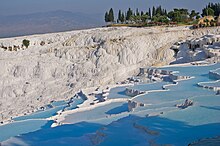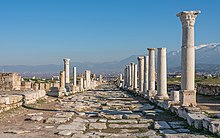Pamukkale
[1][2] It is located in Turkey's Inner Aegean region, in the River Menderes valley, which has a temperate climate for most of the year.
[1] The Turkish name refers to the surface of the shimmering, snow-white limestone, shaped over millennia by calcite-rich springs.
[2] Dripping slowly down the mountainside, mineral-rich waters collect in and cascade down the mineral terraces, into pools below.
Pamukkale's terraces are made of travertine, a sedimentary rock deposited by mineral water from the hot springs.
It remains unclear whether this name referred to the original temple (ἱερόν, hieron) or honoured Hiera, the wife of Telephus, son of Heracles and the Mysian princess Auge.
Originally a see of Phrygia Pacatiana,[9] the Byzantine Emperor Justinian raised the bishop of Hierapolis to the rank of metropolitan in 531.
The museum contains historical artifacts from Hierapolis, as well as those from Laodiceia, Colossae, Tripolis, Attuda and other towns of the Lycos (Çürüksu) valley.
The museum also has a section devoted to artifacts found at Beycesultan Hüyük that includes examples of Bronze Age craft.
The museum's exhibition space consists of three halls[clarification needed] of the vaulted Hierapolis Bath buildings and the open-air areas in the eastern side which are known to have been used as the library and gymnasium.








